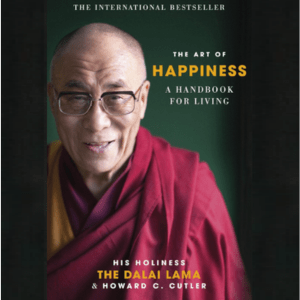Dalai Lama’s “The Art of Happiness”: Insights for Lasting Joy

The quest for happiness is a universal endeavor, and few have explored it with as much depth and wisdom as the Dalai Lama. In collaboration with psychiatrist Howard C. Cutler, the Dalai Lama delves into the nuances of achieving eternal happiness in their book, “The Art of Happiness.” This book, now celebrating its 20th anniversary, offers practical wisdom on achieving lasting happiness by combining the Dalai Lama’s eastern spiritual tradition with Dr. Howard C. Cutler’s western perspective. This book is not just a philosophical treatise; it is a practical guide filled with profound insights and actionable advice. Let’s explore this remarkable work, dissecting its five parts and fifteen chapters, and uncover the key learnings it offers.
“The Art of Happiness” – Summary
Part 1: The Purpose of Life
In this section, the authors explore the fundamental question: What is the purpose of life? The Dalai Lama emphasizes that our ultimate goal is happiness, and he discusses how to find meaning and fulfillment. The Dalai Lama emphasizes that true happiness isn’t about external circumstances, but rather about cultivating inner peace and a sense of well-being.
Chapter 1: The Right to Happiness
The Dalai Lama begins by asserting that the very purpose of life is to seek happiness. He emphasizes that this quest is a fundamental right for every human being. The chapter explores the nature of happiness and the common misconceptions surrounding it. Unlike fleeting pleasures, true happiness is a state of being that requires inner peace and contentment.
Chapter 2: The Source of Happiness
In this chapter, the Dalai Lama discusses the internal and external sources of happiness. While external factors such as wealth and success can contribute to happiness, they are not sufficient on their own. True happiness comes from within, through a balanced mind and a compassionate heart.
Part 2: Human Warmth and Compassion
Here, the book explores the power of genuine human connection. The Dalai Lama argues that genuine happiness is intertwined with our relationships with others. Developing compassion, kindness and a sense of universal responsibility are key to fostering meaningful connections.
Chapter 3: A New Model for Intimacy
The Dalai Lama and Cutler highlight the importance of human connections in achieving happiness. This chapter introduces a new model for intimacy based on mutual respect and compassion. It emphasizes that deep, meaningful relationships are essential for personal fulfillment.
Chapter 4: Deepening Our Connection to Others
Building on the previous chapter, this section explores practical ways to deepen our connections with others. It discusses the importance of empathy and active listening, and how these can enhance our relationships and, in turn, our happiness.
Part 3: Transforming Suffering
Life is inevitably filled with challenges. This section equips readers with tools to navigate hardship. The book discusses how to transform adversity into growth. The Dalai Lama emphasizes the importance of reframing negative experiences, using them as opportunities for growth and transformation. The authors explore resilience, acceptance, and the power of a positive mindset.
Chapter 5: Facing Suffering
Suffering is an inevitable part of life, but how we respond to it can make all the difference. This chapter encourages readers to face their suffering head-on rather than avoiding it. By confronting pain and understanding its causes, we can begin the process of healing.
Chapter 6: Self-Created Suffering
Many of our problems are self-created through negative thinking and destructive habits. The Dalai Lama offers insights into recognizing and overcoming these self-imposed obstacles. By changing our mindset, we can reduce our suffering significantly.
Chapter 7: Shifting Perspective
Perspective is everything. This chapter explores how shifting our perspective can transform our experience of suffering. By adopting a more positive outlook and focusing on the lessons learned from adversity, we can find meaning even in difficult times.
Part 4: Overcoming Obstacles
We all face internal struggles like anger, jealousy, and negativity. This section tackles these obstacles, offering practical strategies for cultivating positive emotions, managing stress, maintaining inner peace even in difficult circumstances, and overcoming self-defeating thoughts.
Chapter 8: Bringing About Change
Change is often daunting, but it is necessary for growth and happiness. The Dalai Lama provides guidance on how to embrace change and make positive shifts in our lives. This involves setting realistic goals and taking actionable steps towards achieving them.
Chapter 9: Dealing with Anger and Hatred
Anger and hatred are powerful emotions that can hinder our happiness. This chapter offers strategies for managing these emotions, such as practicing patience, understanding, and forgiveness. By letting go of anger, we can cultivate inner peace.
Chapter 10: Handling Anxiety and Fear
Anxiety and fear are common obstacles to happiness. The Dalai Lama shares techniques for overcoming these emotions, including mindfulness, meditation, and rational thinking. By addressing our fears head-on, we can reduce their power over us.
Part 5: Closing Reflections on Living a Spiritual Life
The final part brings the book full circle, offering practical advice on integrating these principles into daily life. The Dalai Lama emphasizes the importance of cultivating a spiritual perspective, not necessarily based on religion, but on a sense of purpose and interconnectedness with all living beings. He discusses the intersection of spirituality, happiness, and daily life, emphasizing mindfulness, gratitude, and purposeful living.
Chapter 11: The Meaning of Life
In this contemplative chapter, the Dalai Lama reflects on the ultimate meaning of life. He suggests that living a life of purpose and compassion is the key to lasting happiness. This involves not just seeking personal fulfillment, but also contributing to the well-being of others.
Chapter 12: The Role of Spirituality
Spirituality, according to the Dalai Lama, is an essential component of a happy life. This chapter explores the role of spiritual practices, such as meditation and prayer, in cultivating inner peace and compassion. Spirituality is not limited to religious beliefs; it is about finding a deeper connection to the world and ourselves.
Chapter 13: Finding Balance
Balance is crucial for a happy life. This chapter discusses how to balance work, relationships, and personal growth. The Dalai Lama emphasizes the importance of self-care and maintaining harmony between our physical, emotional, and spiritual needs.
Chapter 14: Cultivating Inner Contentment
Inner contentment is the foundation of happiness. This chapter provides practical advice on how to cultivate contentment through gratitude, mindfulness, and self-awareness. By appreciating what we have and living in the present moment, we can achieve a state of lasting happiness.
Chapter 15: Living a Meaningful Life
The final chapter ties together the book’s themes, offering a comprehensive guide to living a meaningful life. The Dalai Lama encourages readers to pursue their passions, help others, and live in accordance with their values. By doing so, we can create a life that is not only happy but also deeply fulfilling.
Key Learnings from the Book
The Art of Happiness offers a wealth of wisdom for those seeking a more fulfilling life. Key takeaways:
- Happiness is a Choice: Happiness is not solely dependent on external circumstances.
- Compassion is Key: Developing compassion for ourselves and others is essential for lasting happiness.
- Transform Suffering: Difficult experiences can be opportunities for growth if we approach them with acceptance, resilience, and the power of the mind.
- Manage Your Emotions: Overcoming obstacles involves mastering our emotions and cultivating positive mental states. Learn to recognize and manage negative emotions in a healthy way.
- Live a Spiritual Life: Spiritual growth and a sense of purpose contribute significantly to our overall happiness and well-being. Cultivate a sense of purpose and interconnectedness with all living beings.
Practical Strategies for “The Art of Happiness”
In “The Art of Happiness,” several practical strategies are highlighted to help individuals cultivate compassion and kindness in their daily lives. Here are some key strategies mentioned in the book:
- Practicing Empathy: The book emphasizes the importance of putting ourselves in others’ shoes and trying to understand their perspective. By actively listening and empathizing with others, we can develop a deeper sense of compassion.
- Random Acts of Kindness: Engaging in small acts of kindness, such as helping a stranger, showing appreciation, or offering a helping hand, can cultivate a compassionate mindset and create a ripple effect of positivity.
- Cultivating Gratitude: The authors discuss the power of gratitude in nurturing kindness. By regularly expressing gratitude for the blessings in our lives, we develop a greater appreciation for others and become more inclined to extend kindness towards them.
- Mindful Communication: The book emphasizes the importance of mindful communication, which involves being present, attentive, and non-judgmental during conversations. This practice allows for more compassionate and understanding interactions.
- Self-Compassion: The authors highlight the significance of extending compassion to oneself. By practicing self-care, self-acceptance, and self-compassion, individuals can replenish their emotional reserves and extend kindness to others more genuinely.
- Forgiveness: The book explores the transformative power of forgiveness. By letting go of grudges and resentments, individuals open themselves to compassion and create space for healing and growth.
- Cultivating Inner Peace: The authors emphasize the importance of cultivating inner peace through practices such as meditation, mindfulness, and self-reflection. By nurturing a calm and centered mindset, individuals can approach others with kindness and compassion.
These practical strategies are intended to be integrated into daily life, allowing individuals to develop a compassionate mindset and foster positive connections with others. By consistently applying these strategies, individuals can make a positive impact on both their own well-being and the well-being of those around them.
Conclusion
“The Art of Happiness” by the Dalai Lama and Howard C. Cutler is a profound and practical guide to achieving lasting happiness. Through its five parts and fifteen chapters, it offers deep insights and actionable advice on living a fulfilling life. By focusing on inner peace, compassion, and personal growth, we can transform our lives and find true happiness.
Remember, happiness is a journey, and “The Art of Happiness” provides valuable insights to help us navigate it.
Frequently Asked Questions
What is the main message of “The Art of Happiness”?
The main message is that happiness is a state of mind that can be cultivated through inner peace, compassion, and personal growth.
How does the book suggest one can achieve happiness?
The book suggests achieving happiness by developing a compassionate heart, facing suffering head-on, embracing positive change, and cultivating balance and contentment.
What role does compassion play in the book?
Compassion is seen as crucial for deepening relationships and achieving true happiness. It helps create a sense of connection and mutual respect.
Are there any practical exercises in the book?
Yes, the book includes practical exercises such as mindfulness practices, meditation techniques, and strategies for managing emotions like anger and anxiety.
Who would benefit most from reading this book?
Anyone seeking to improve their happiness, cultivate inner peace, and develop a more compassionate outlook on life would benefit from reading “The Art of Happiness.”


You have noted very interesting details! ps decent website.
you have got an amazing blog here! would you wish to make some invite posts on my blog?